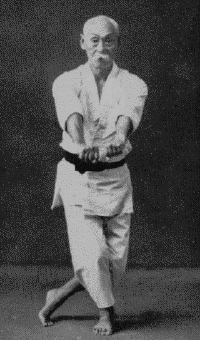
SENSEI
Those who made the road before
Chomo Hanashiro
1869-1945
Chomo Hanashiro was born in 1869. At an early age he began training with Sokon 'Bushi' Matsumura. Matsumura was quite an old man at the time and Hanashiro was primarily a student of one of Matsumura's senior students, Ankoh Itosu. Hanashiro remained with Itosu, and acted as an assistant instructor for him up until his death in 1915.
From early in the 20th century, Hanashiro taught gymnastics at a junior high school in Shuri which gave him an excellent opportunity to aid Itosu in the introduction of Tote into the school system.
Hanashiro and Kentsu Yabu, also a originally student of Matsumura, shared many common experiences and have remarkably similar karate careers. Both were noted as having exceptional physiques in the 1891 Japanese army draft's medical exams. They were both pioneers in instructing karate in the school system in the first decade of the 20th century, and also taught Tote in military schools. Both were also present at the famous Oct. 25th, 1936 meeting of Okinawan Masters.
Hanashiro was not only a pioneer in the school system, he pioneered the use of the word "karate". In his August 1905 publication, "Karate Shoshu Hen" (AKA "Karate Kumite"), we can see the first known use of the modern kanji. The original two characters for the art were pronounced Tote meaning, "China Hand." The first character, however, could also be pronounced "kara." This character was changed to another that had the same pronunciation ("kara"). Thus the modern term "Karate-te (empty hand) appeared.
 To-te='China' Hand
To-te='China' Hand
Kara-te='Empty' Hand
Hanashiro was one of the primary instructors for an organization formed in the early 1920's in Okinawa called the Ryukyu Tote Kenkyukai (Okinawan Tote Research Club). The club was an expansion of an earlier organization formed in 1918 by Chojun Miyagi, founder of Goju Ryu. Originally the organization was meant to continue the teachings of Ankoh Itosu, Kanryo Higa(shi)onna and Seisho Aragaki, the last generation of masters who had died between 1915 and 1918, leaving a great void.
1945 was a horrific year for karate and for Okinawa in general. The "Battle of Okinawa" was fought and Okinawa was relentlessly pounded by U.S. artillery and occupied by U.S. troops. Approximately 60,000 civilians were killed during the 82 days of fighting. The time after the battle was no less forgiving and many died of starvation and disease, including many karate masters and their students. Chomo Hanashiro was one of the unfortunate victims of this time.